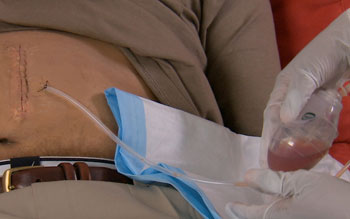Introduction to Care of Drains and Drainage Bags

Sometimes, after surgery or when a person has a traumatic wound, a surgeon places the tip of a rubber drain into the person’s wound to drain fluid out more freely. A wound must drain well for it to heal. It is important to remove all wound drainage to ensure that bacteria and fluids are no longer present in the bottom of the wound (the wound bed). When fluids are not able to drain, but build up inside a wound, infection can form.
Examples of conditions that require the use of wound drainage devices in the home include:
- Delayed healing of a surgical wound. (Patients with diabetes, those who are overweight, or those who have a weak immune system, are at a greater risk for delayed wound healing).
- A traumatic wound, such as one caused by a dirty object entering the skin, is at high risk for infection. This may happen after a car accident, when a sharp object pierces the skin, or from an accident involving farm equipment.
- Most major surgeries involving joints or bones such as total knee or hip replacement.
When you provide care to someone with a wound drainage device, you need to know:
- The purpose of the device and how to care for it properly, including how to empty a device and set the vacuum.
- Infection control practices
- Proper methods for disposal of medical waste.
See our Lessons on Infection Control and Medical Waste. Managing a wound drainage device is safe and easy as long as you follow the principles reviewed in this lesson.
Here is Erica’s story:

My father smokes and is an overweight diabetic. Last month he had emergency surgery for a bowel obstruction. The wound did not heal as planned and my father came home from the hospital with a Jackson-Pratt drain. His incision was partially opened and the Jackson-Pratt drain needed to be emptied at least every 8 hours. As a family, we did not know how we were going to manage this draining wound and help Dad recover. It was overwhelming. The first few days were scary for all of us. To be helpful, I moved in with my parents when dad came home.
The home health nurse visited us every day for a week to help us and make sure we were doing everything correctly. Once my mother and I learned how to empty the drainage device and dispose of the drainage, everything got a lot easier; even my father sometimes helps out. At first it was hard to figure out the best way to get rid of the wound drainage and the gauze dressings, but the nurse showed us how to flush the drainage down the toilet correctly and double bag the old dressings for the trash. It is now two weeks since my father left the hospital and Mom is now comfortable with me going back home.